
The Ogasawara subtropical moist forests is a terrestrial ecoregion which encompasses the Ogasawara Archipelago of Japan. The Ogasawara Archipelago lies in the Pacific Ocean south of Honshu, Japan's largest island, and north of the Marianas Islands. The ecoregion includes the Bonin Islands and Volcano Islands chains. The islands are volcanic in origin, and have never been linked to a continent. They are home to distinct plants and animals including many endemic species.

Syzygium cumini, commonly known as Malabar plum, Java plum, black plum, jamun, jaman, jambul, or jambolan, is an evergreen tropical tree in the flowering plant family Myrtaceae, and favored for its fruit, timber, and ornamental value. It is native to the Indian subcontinent and Southeast Asia, including Myanmar, Sri Lanka, Bangladesh and the Andaman Islands. It can reach heights of up to 30 metres (98 ft) and can live more than 100 years. A rapidly growing plant, it is considered an invasive species in many world regions.

Syzygium densiflorum is a species of evergreen tree in the family Myrtaceae. It is endemic to the Western Ghats mountains, India. The species is categorised as Vulnerable in the IUCN Red List.
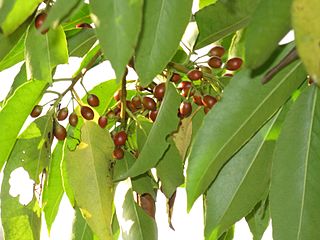
Ilex chinensis, the Kashi holly, oriental holly, or purple holly, is a species of flowering plant in the family Aquifoliaceae, native to Vietnam, southern China, Taiwan, and central and southern Japan.

Syzygium forte, commonly known as flaky-barked satinash, white apple or brown satinash, is a tree in the family Myrtaceae native to New Guinea and northern Australia.

Syzygium claviflorum is a tree in the Myrtaceae family. It is native to the north of the Australian continent and in tropical and subtropical Asia. It is used for timber, as fuel, as human and cattle food, and for dye. Stunted specimens can be found on the top of the plateau of Bokor National Park, Cambodia.
Castanopsis sclerophylla, the Chinese tanbark-oak, is a species of flowering plant in the family Fagaceae, native to southern China. In the wild it is typically found growing in broad-leaved evergreen forests at 200 to 1,000 m above sea level. It is an evergreen tree with glossy, thick leaves and attractive flaky bark, and reaches 20 m (66 ft) in height.
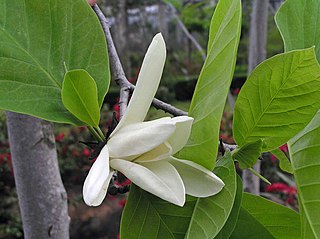
Magnolia chapensis is a species of flowering plant in the family Magnoliaceae, native to southern China and northern Vietnam. A tree reaching 30 m (100 ft), it is hardy to USDA zone 7b. It has found wide use as a street tree in southern Chinese cities.

Celtis julianae, the Julian hackberry, is a species of flowering plant in the family Cannabaceae, native to central and southern China. It is a fast-growing deciduous tree with gray bark reaching 80 ft (24 m). In the wild it is typically found growing in forested valleys and on slopes at 300 to 1,300 m above sea level.

Gleditsia japonica, the Japanese locust, is a species of flowering plant in the family Fabaceae, native to the eastern Himalayas, central and southern China, Manchuria, Korea, and central and southern Japan. It is used as a street tree in a number of cities in China and Europe.
Ormosia henryi is a species of flowering plant in the family Fabaceae, native to southern China, Vietnam, and Thailand.
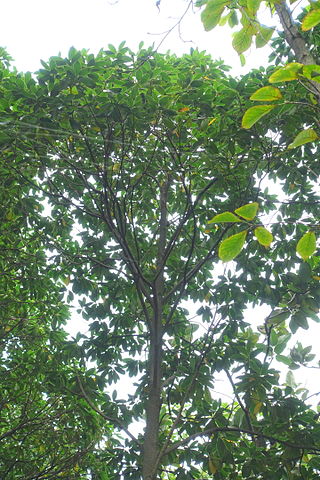
Magnolia lotungensis, the eastern joy lotus tree, is a species of flowering plant in the family Magnoliaceae, native to southern China, including Hainan. An androdioecious, hexaploid evergreen tree reaching 30 m (98 ft), it is typically found in forests from 700 to 1,400 m above sea level. It is used as a street tree in a number of southern Chinese cities. Due to its strength, easy maintenance, narrow growth habit with a rounded crown, and cold hardiness, it is showing promise as an ornamental tree in North America and Europe.
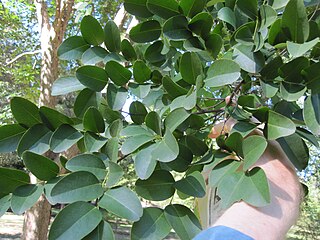
Dalbergia hupeana, the hardy rosewood, is a species of flowering plant in the family Fabaceae, native to subtropical areas of Laos, Vietnam, southern and central China, and southwestern South Korea. In the wild it prefers to grow on forested or scrubby slopes.

Castanopsis eyrei is a species of flowering plant in the family Fagaceae, native to southern China, and Taiwan. An evergreen tree typically 8 to 20 m tall, it is usually found in late successional forests from 300 to 1,700 m above sea level, where it is often the dominant species. It is used as a street tree in a number of southern Chinese cities.
Ilex macrocarpa is a species of flowering plant in the holly family Aquifoliaceae, native to central and southern China, and Vietnam. A deciduous tree typically 5 to 10 m tall, it is found in a wide variety of temperate habitats, including roadsides, from 400 to 4,500 m above sea level. It differs from other hollies by its large black fruit. It is used as a street tree in Hefei, China.
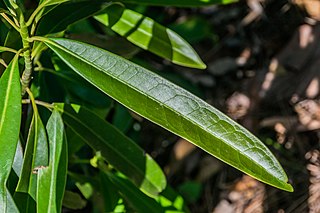
Magnolia insignis, the red lotus tree, is a species of flowering plant in the family Magnoliaceae, native to Nepal, Assam, Tibet, southern China, Myanmar, Thailand and Vietnam. It is used as a street tree in a number of southern Chinese cities.

Zelkova schneideriana, the Chinese zelkova, is a species of flowering plant in the family Ulmaceae. It is found in southeastern Tibet, and central and southern China, usually alongside streams. A fast-growing deciduous tree with attractive exfoliating bark, it can reach 35 m (115 ft) tall and have a DBH of 80 cm (31 in). Although highly resistant to honey fungus, it can still (rarely) be afflicted with Dutch elm disease.
Cinnamomum bodinieri is a species of flowering plant in the family Lauraceae, native to southern China. A tree reaching 16 m (52 ft), it is typically found in situations with more light, such as alongside roads and streams or in open forests and thickets. Its essential oil is high in citral. It is used as a street tree in a number of southern Chinese cities.

Thevetia ahouai is a species of flowering plant in the family Apocynaceae, native to Mexico, Central America, Cuba, Colombia, and Venezuela, and introduced to southeastern China. An evergreen shrub or small tree of forests reaching 3 m (10 ft), it is used as a street tree in Nicaragua and Colombia.
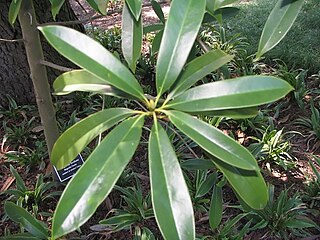
Magnolia fordiana is a widespread species of flowering plant in the family Magnoliaceae, native to southern China, Hainan, and Vietnam. An evergreen tree reaching 25 m (82 ft) tall, it is found in hilly forests, often beside rivers, at elevations from 300 to 1,200 m. Specialists in Magnolia believe that most Magnolia fordiana specimens offered for sale are actually the closely related Magnolia yuyuanensis, a more attractive tree and one that is better adapted to cultivation. It is widely used as a street tree in southern Chinese cities.


















